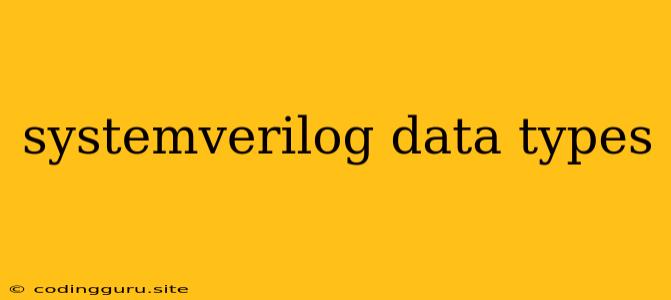Understanding SystemVerilog Data Types: A Comprehensive Guide
SystemVerilog, a hardware description language (HDL), plays a crucial role in designing and verifying complex digital circuits. One of the fundamental aspects of SystemVerilog is its data type system, which provides a wide range of data representation options for modeling different types of digital information. This comprehensive guide aims to equip you with a deep understanding of SystemVerilog data types, empowering you to confidently tackle your hardware design and verification projects.
What are SystemVerilog Data Types?
SystemVerilog data types define the characteristics of data used in your hardware designs. They specify the range of values a variable can hold, the operations that can be performed on it, and how it is represented in memory. Understanding these data types is essential for building accurate and efficient hardware designs.
Fundamental SystemVerilog Data Types:
SystemVerilog provides a set of fundamental data types, each serving a specific purpose:
**1. integer: **
- Represents signed integers.
- Holds values from -2^31 to 2^31-1 (32-bit range).
- Useful for representing signed quantities like temperature, pressure, or counters.
**2. reg: **
- Stores individual bits or collections of bits.
- The most basic data type used to model signals and registers in hardware.
- Can hold values from 0 to 1, allowing for binary representation.
**3. wire: **
- Represents electrical wires or connections within your circuit.
- Used for modeling data flow and propagation between different components.
- Can also be used for modeling inputs to your design.
**4. logic: **
- Introduced in SystemVerilog, replacing the traditional
wiredata type. - Provides a more flexible representation for both combinational and sequential logic.
- Allows for both 4-state logic (0, 1, X, Z) and 2-state logic (0, 1).
**5. bit: **
- Represents a single bit of data.
- Useful for modeling individual flags or status indicators.
**6. byte: **
- Represents an 8-bit unsigned value.
- Used for storing small amounts of data like characters.
**7. shortint: **
- Represents a 16-bit signed integer.
- Often used for smaller signed quantities or addressing.
**8. int: **
- Represents a 32-bit signed integer.
- Commonly used for general-purpose integer calculations.
**9. longint: **
- Represents a 64-bit signed integer.
- Used for representing larger signed values or performing more complex calculations.
**10. real: **
- Represents floating-point numbers, allowing for fractional values.
- Useful for modeling physical quantities with decimal values or performing calculations involving real numbers.
**11. time: **
- Represents time values in SystemVerilog simulations.
- Used for measuring simulation execution time or setting time delays.
**12. string: **
- Represents a sequence of characters.
- Useful for storing text strings or messages.
**13. struct: **
- Allows you to group different data types into a single structure.
- Provides a way to organize related data and access it using member variables.
**14. union: **
- Similar to a struct, but different members share the same memory location.
- Useful for saving memory when you only need to access one member at a time.
**15. enum: **
- Creates a set of named constants, providing a more descriptive and readable way to represent values.
- Improves code readability and maintains consistency.
Understanding Data Type Sizes and Ranges:
- Data Types and Bit Widths: SystemVerilog data types can have fixed or variable bit widths.
- Fixed Width: For example,
byteis always 8 bits,intis 32 bits, andlongintis 64 bits. - Variable Width: You can define your own data types with specific bit widths using
typedef. For example,typedef logic [7:0] my_byte;creates a custom data type namedmy_bytethat holds 8 bits of data.
Choosing the Right Data Type:
- Functionality: Consider the type of operations you need to perform. If you need signed arithmetic, use
integer. For storing individual bits, usereg. For representing real numbers, usereal. - Memory Requirements: Be mindful of the size of your data types and how they impact memory usage, especially when working with large arrays or complex structures.
- Readability: Choose data types that make your code clear and easy to understand. Use descriptive names for custom data types defined with
typedef. - Performance: Some data types might offer better performance for certain operations. For example,
logiccan be faster thanregfor certain tasks.
Examples of Data Types in SystemVerilog:
// Declaring variables of different data types
reg [7:0] my_byte; // 8-bit register
integer count; // 32-bit signed integer
real temperature; // Floating-point number
string message; // String of characters
time simulation_time; // Time value
// Defining a custom data type with typedef
typedef logic [31:0] custom_int;
custom_int my_number; // 32-bit custom integer
// Using an enum to represent states
enum { IDLE, PROCESSING, DONE } state;
Tips for Effective Data Type Management:
- Utilize
typedef: Create custom data types to enhance code readability and maintain consistency. - Use appropriate data types: Select the data type that best suits the specific data you need to represent.
- Document your data types: Include comments explaining the purpose and usage of custom data types.
- Avoid unnecessary data type conversions: Conversions can impact performance. Use the appropriate data type from the start.
Conclusion
A comprehensive understanding of SystemVerilog data types is crucial for creating accurate, efficient, and maintainable hardware designs. By mastering the fundamental data types, understanding their size and range, and utilizing appropriate data type management techniques, you can elevate your SystemVerilog skills and tackle complex hardware design and verification challenges with confidence.
